Children's inflatable pools: characteristics and selection

Small children love water: swimming, fooling around and playing with different toys. It is especially great when, on a hot summer day, a child can splash not only in the bathroom. But unfortunately, not everyone has the opportunity to take their child to the pool or take out to the sea.
But there is a way out of the situation: you need to buy an inflatable children's pool, which will diversify his leisure time and bring a lot of joy. We will talk about what types of such products are and how to choose them correctly in this article.

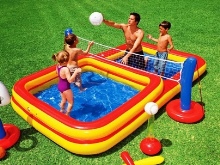

Peculiarities
The inflatable children's pool is a holistic structure made of polyvinyl chloride. Its elements are the bottom, the wall and the top ring. Such an attribute for outdoor activities is now very popular. But given the fact that the product is made for children, there are many requirements for it:
- absolute safety of the structure as a whole and its individual components;
- use in the production process of exclusively high-quality and environmentally friendly materials and raw materials - PVC, synthetic rubber, polyester, nylon;
- availability of quality certificates.
Each of the manufacturers of such pools must adhere to a certain production technology and comply with the rules and regulations provided by law.



What is the popularity of the design? It's all about its features, namely:
- the material from which a children's pool can be made passes a mandatory check for compliance with standards, environmental friendliness and safety;
- the use of high-quality materials and raw materials contributes to the fact that the structure can withstand heavy loads;
- reasonable price - inflatable pools are more affordable than their "rigid" counterparts;
- wide selection and assortment of shapes, colors, sizes;
- the structure is easy to install, assemble and store;
- mobility;
- versatility;
- ease of care;
- long service life when used correctly.

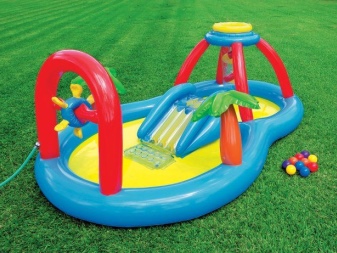
It is worth noting that many models are equipped with various additional elements, for example, a slide, inflatable fish and animals. The presence of such accessories will definitely please the child and make bathing even more fun.
Of course, it is worth noting the disadvantages of the product:
- low strength;
- susceptibility to damage - both a sharp object or stone and weather conditions can damage the structure;
- it burns out from exposure to ultraviolet radiation, so it is not recommended to leave the pool under the open sun for a long time.

Types and models
The demand for inflatable pools is growing every day, so it is not at all surprising that the range of these products on the market is also increasing. It is classified according to these parameters.

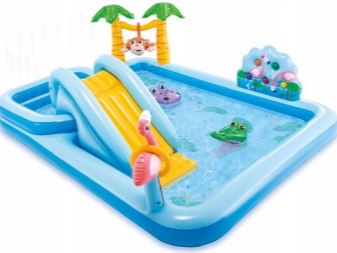
Tank depth
This is very important and must be taken into account. It is determined by the age of the child:
- no more than 17 cm - this is a small pool for babies and children up to 1.5 years old;
- up to 50 cm - an option for a child under 3 years old;
- up to 70 cm - for babies up to 5 years old;
- up to 150 cm - suitable for a child who already swims well and is not afraid of water.
Models, which are intended for very young children, are shallow for obvious reasons.


Design
In this case the manufacturer did his best and created all possible designs of an inflatable pool:
- with a slide;
- with and without a roof;
- with a canopy;
- with a ladder;
- in the form of a house or jacuzzi;
- in the form of a large play complex, etc.



The form
The pool can be round, oval, square, rectangular. That's just when choosing, take into account that there is enough free space for installing the structure.


Volume
The dimensions of the structure and the number of people who can simultaneously be in the pool depend on this parameter. As you can see, the variety of products is quite large. You can even buy a small pool for your child and put it in the shower, or a large one that you can take with you to the beach. I would also like to say a few words about the manufacturers. Products from different companies are presented on the market today. The most reliable and popular are the following manufacturers of inflatable pools:
- Bestway - the model 55030 "Rybki" is in demand;
- Intex - the goods of this company are very popular, most often the consumer buys a children's inflatable game complex 57444;
- Jilong - when choosing, you should pay attention to the Jilong 17011 model;
- Little tikes - the model 632914 "Aquapark" is in the greatest demand from this company.
Each of the above manufacturers has long been presenting their products on the market of children's products for outdoor activities, guaranteeing the quality and reliability of products.


How to choose?
Choosing an inflatable pool for a child, there are many factors and criteria to be considered:
- the age of the child - each category has its own design models;
- pool volume and size;
- the material from which the product is made;
- the seller has documents that confirm the safety of the product;
- the presence of a water valve in the pool;
- what is the bottom of the tank - it can be in the form of a thin film or a ribbed cushion;
- the presence of additional structures, for example, an awning - these are the models that are most preferable for young children;
- the quality of the sides - they must be rigid and wide.
Also, do not forget to first decide on the place where you will install the pool.

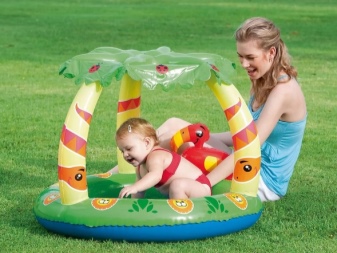
How to inflate?
The basis of all models of inflatable pools is an air cushion. And before you fill the tank with water, you need to pump it with air. Manipulation is performed using a pump, which must be included in the kit. This is the simplest, fastest and most correct pumping option. But in life there are different occasions, for example, we went to the dacha, took the pool with us, and forgot the pump. But there are no hopeless situations, you can cope without a pump. You can inflate the pool using:
- own lungs - the method is not the best, but you can resort to it if the pool is small;
- construction hair dryer - set the minimum temperature on the tool, connect it to the air valve and press the "Start" button, gradually increasing the heating rate. This method can be applied to small to medium sized tanks.
As for the volumetric structures, unfortunately, they cannot be inflated with either a building hairdryer or lightweight ones. Therefore, it is still better not to forget the pump specially designed for this.


How to care?
Proper care and operation is the key to the durability of the product. An inflatable pool is a rather delicate thing that needs to be properly looked after.
Let's start by talking about how to operate a pool. There are certain rules that are indicated by the manufacturer in the instructions for its use. They read:
- the tank must be installed on a flat surface without sharp objects, grass and roots;
- watch the temperature of the water in the tank - it should not fall below 22 ° C;
- the structure should not be exposed to direct sunlight for a long time - this is due to the fact that under the sun the pool will begin to descend, and the material from which it is made may be damaged;
- it is desirable that near the installation site of the tank there is a water source and a sewer drain or a pit into which water can be drained.

As for the care of the product, here you need to adhere to the following recommendations:
- after purchase, before use, treat the tank with special degreasing agents inside and out;
- rinse well;
- it is advisable to change the water every day so that it does not stagnate and a new life does not appear in the pool in the form of microbes and fungi;
- for prevention, the manufacturer recommends during operation, for example, once a week, to treat the pool with special preparations or dissolve tablets in water - this manipulation will prevent the appearance of mold, microbes and fungus, thereby protecting the child from diseases;
- after the end of the season, the pool must be deflated, only before that you need to drain the water, wipe it and dry it;
- when the pool is completely dry, it must be carefully folded and packed in its original container.
For storage, it is better to choose a dry and well-ventilated area.

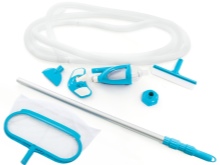

How to glue?
We have previously written that the structure of the pool is very easy to damage - the material does not have a high level of resistance to mechanical stress. The biggest problem with inflatable pools is punctures. It will not be difficult to understand that it is damaged: the product will immediately begin to deflate, and will cease to keep its shape. This unpleasant situation can be repeated throughout the entire life of the tank. Everything can be fixed and repaired by yourself at home. Follow the instructions below.
The first step is to find the puncture site. There are several methods to help you identify the "hole" in the pool.
- Inflate each ring in turn and immerse it in a reservoir of water. The air that will leave the ring through the puncture will form bubbles on the surface of the water. This place needs to be marked with a marker or pen, since then it will need to be glued.
- The second method is suitable if the tank is large. To find a hole, you only need laundry soap, from which you need to beat the foam. It is applied to each ring of the structure. Next, you need to carefully monitor where bubbles begin to form.
After you have found the puncture points, you can start gluing them.

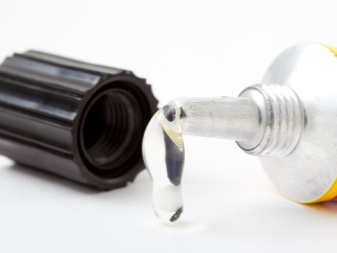
There are also several options for sealing a puncture in a pool.
- This is the fastest way when the tank needs to be repaired urgently and there is no time to find a special tool or glue. In this case, you can not do without stationery tape. The puncture site must first be rubbed with sandpaper, dried and then glued with a piece of scotch tape. Such repairs will last a maximum of a week.
- You will need a rubber patch and superglue to fix the hole. The pool surface at the puncture site is degreased. Next, you need to apply glue to the puncture and to the patch, seal the hole. It is not recommended to use the pool for 12 hours.
- This repair is within the power of those who have a car, because to complete it you will need a kit for vulcanizing car chambers. The process of gluing the puncture is similar to the previous two.
- When buying a pool, it is advisable to purchase a repair kit from the manufacturer. It includes special degreasing agents, glue and PVC patches.
Of course, if you have the opportunity and desire, you can contact a specialized company that provides services for the repair of inflatable pools.


In the next video, you will find a brief overview of the Intex children's inflatable pool for summer cottages.



































































The comment was sent successfully.